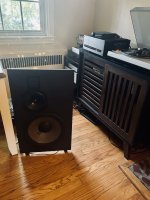Please may I know what is the function of the 2 switches?Here are some pics of one of the two Aleph J's I have completed. Thanks Nelson for sharing you knowledge with the community.
Nice and Understated 👏A40
20 years ago I purchased the partial kit from Old Colony. Stuffing the boards is as far as I got. Then recently...
Thank you for a sweet sounding amplifier Mr. Pass!
Should the thermistor be stick to a heatsink? Or just leave it in free air?Tim, also keep a close eye on those in-rush limiters (thermistors). Depending on your amps operating condition, they can run very hot--and it looks as though you have them mounted on/near wood.....
Unless you're into the aromatherapy of burnt pine, this might be a problem....
Ken
2 Switches?Please may I know what is the function of the 2 switches?
Are you referring to the retaining clip releases on the XLR jacks?
That's not my build... but this is a picture of the back panel in the photos you linked to above.
One power switch. Two XLR jacks for inputs.
Is this the common problem of Single ended class A amplifier built? Owing to the enormous heatsink required, we often ended up with super large casings with lots of extra space in it.
F4 crammed into a 4U mini-Dissipante chassis from Modushop. I think many DIYers use the full-size Dissipante because it is easier to work with. This takes some extensions, a universal joint, contortions and occasional cussing to get it apart and back together.
Next step is to do what @von Ah did, make a separate power supply chassis but been busy with a new house and other audio projects.
Next step is to do what @von Ah did, make a separate power supply chassis but been busy with a new house and other audio projects.
Attachments
I found an external PSU always delivers in regard to space and easy access.
In fact all my projects with the exception of one tube pre-amp have an external PSU.
Even my Technics turntables get an external PSU as a matter of course.
Obviously that means more plugs, sockets and cables but I think, at least for me, it's the better and easier approach.
In fact all my projects with the exception of one tube pre-amp have an external PSU.
Even my Technics turntables get an external PSU as a matter of course.
Obviously that means more plugs, sockets and cables but I think, at least for me, it's the better and easier approach.
I have been doing external power supplies for years. Most of the Mr. Nelson amps share the same power supply.
I am definitely going to have an external PSU, a hefty one, so that it can be reused with other amplifiers, without having to reinvest in another PSU.In fact all my projects with the exception of one tube pre-amp have an external PSU.
Even my Technics turntables get an external PSU as a matter of course.
Obviously that means more plugs, sockets and cables but I think, at least for me, it's the better and easier approach.
But that leaves even more empty space in the casing, when the amplifiers call for humongous heatsink.
Last edited:
Are you using the same voltage for all the amps?I have been doing external powers supplies for years. Most of the Mr. Nelson amps share the same power supply.
I am in the process of ordering my transformers, started with wanting one with 24X2 + 12X2, same current rating for all four, so that I could use either 12V, 24V and 36V.
But when I analysed it, it doesn’t appear to be as cost effective as I think, for:
1) the full transformer rating will only be utilised when I use 36V x 2, when I use 12 and 24 I will only be using 1/3 or 2/3 of the rating, so if I want 600VA for 24V, I will have to spec 900VA for the transformers ==> defeating the purpose of cost savings;
2) transformers with multiple voltages output will have to be made to order, which is actually quite costly, sometimes it may be cheaper to buy another transformer.
My other alternative is to have transformer with output of 48Vx 2, I could connect the 48V in parallel, and with floating earth method I get about +- 32Vdc, or connect that 48V in series and get 64Vdc.
Do you have a cost effective way of having multiple voltages to play with different amp at different time? Without having to resort to a Variac? Which is another costly thing to pay for.
This is the current;y assembled office rig.I had to share it. I still need to put up shelves and things but the sound is putting a big smile on my face as is. The pre with tyhe chicken head knob is a B1R2 with PS, gain stage , 3 source relay selector and power on timed output relay. The DAC is a Grace audio SDAC to be replaced at some point by Miro's NOS DAC. But its is really good! The power Amp is an ACA Mini but reconfigured with new boards to fit in a smaller normal looking power amp chassis. The speakers are Mark Audio CH-70's sealed. I'm listening to Night Train by Oscar Peterson right now. The sound is so very, very good. Thanks for all the great stuff @Nelson Pass !

Even then it can be a bit of a pain. When I got the 4U/300, I thought it was cavernous, but attaching the wires to psu after it was all mounted proved a pain in the a&@. Someone had suggested that I start with the psu instead of the amp first…. Should’ve listened…..I think many DIYers use the full-size Dissipante because it is easier to work with.
- Home
- Amplifiers
- Pass Labs
- Pictures of your diy Pass amplifier


